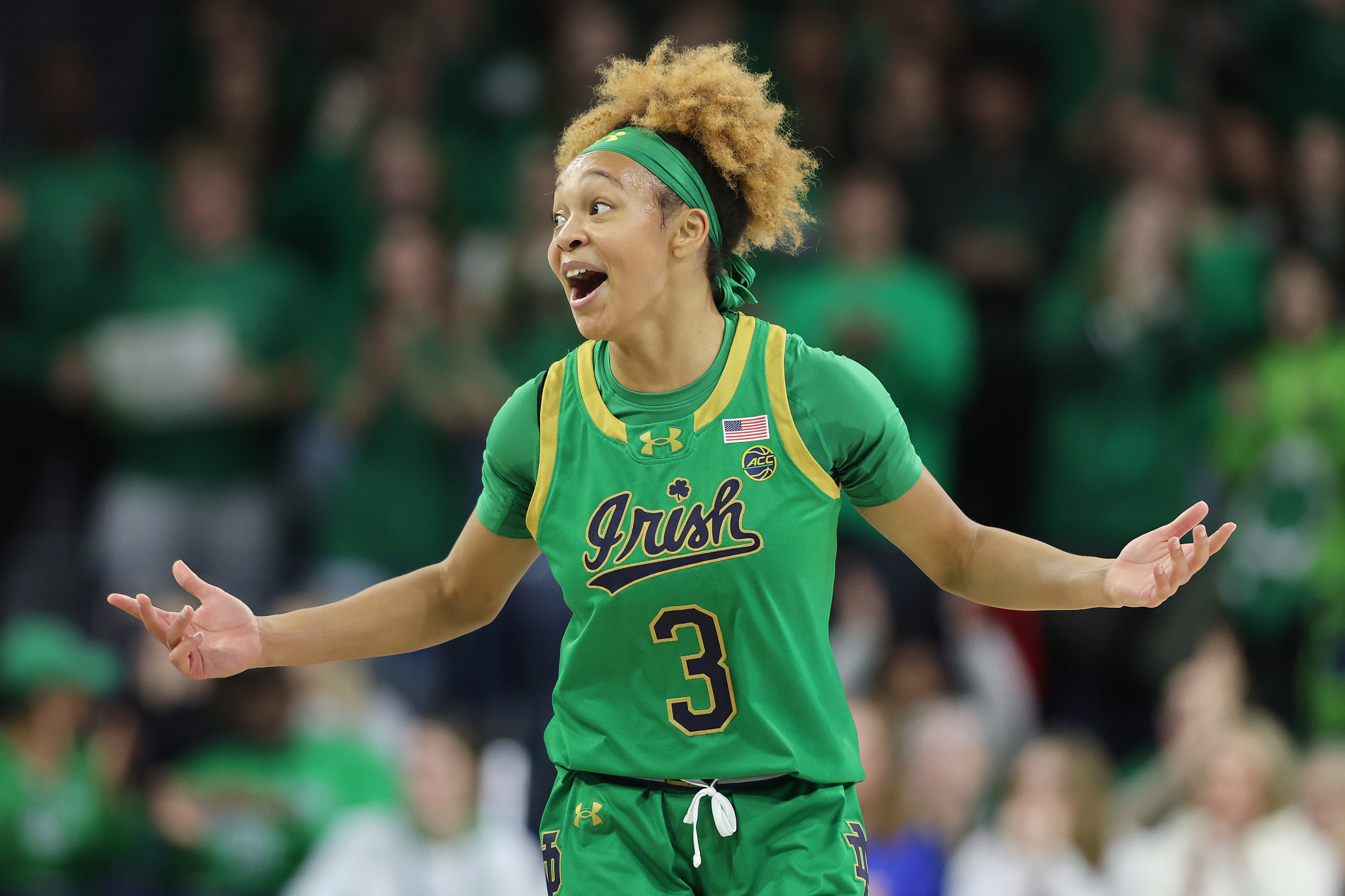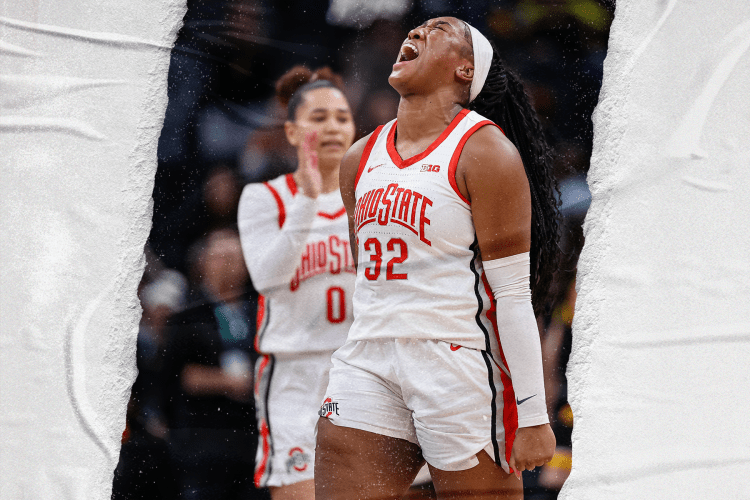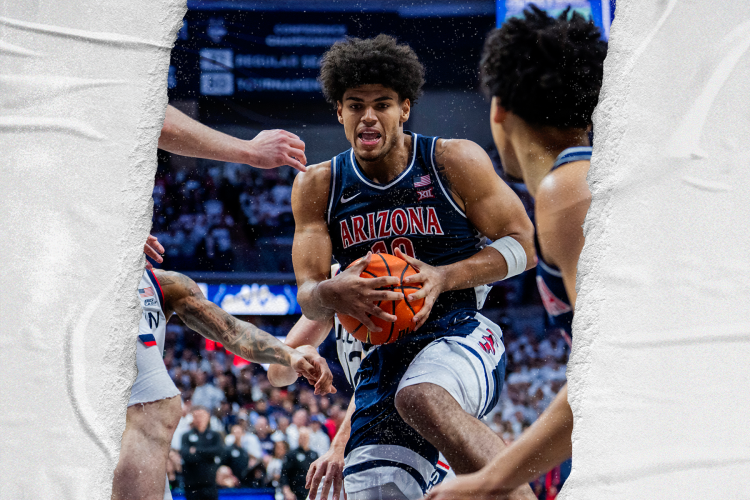You’ve seen Lauren Betts finish with efficiency around the rim and alter shots on defense. You’ve seen Hannah Hidalgo’s rabid intensity on defense and electric playmaking on offense. You’ve seen JuJu Watkins’ smooth finishes and ball-on-a-string moves to the rim. And if you’re locked into the women’s basketball space, you’ve certainly heard the debate surrounding the Player of the Year award, centering around these three players as the top candidates. But who is really leading the race?
Betts, Hidalgo and Watkins all have strikingly different styles of play, both due to their positions and overall skill sets. Because of this, comparison can be tricky. For example, how do we compare offensive impact when Betts takes all of her shots in the paint, while the other two score at three levels? Or what about comparing defensive abilities when 6-foot-7 Betts is blocking shots, the 5-foot-6 Hidalgo is getting steals and the 6-foot-2 Watkins is doing a little bit of both? That’s where advanced stats come in.
I’m going to be comparing the three leading candidates using two metrics: advanced stats and things we can’t chart statistically. Advanced stats — which I am getting from CBB Analytics — simply allow us to interpret things like points scored in a better, more game-like way, while eye-test and non-statistical aspects will always play a part in these kinds of awards because there are always things that can only be captured by watching.
Here is where the POY race stands as of today.
Lauren Betts, 6-foot-7 junior center, UCLA
Betts does all of her work in the paint, so her effective field goal percentage (field goal percentage that takes into account additional points from threes) is the same as her regular shooting percentage, which is super efficient at 64 percent. That’s in the 97th percentile. Meanwhile, her points per 40 minutes average is 27.4, which is in the 99th percentile. Another key part of her game is second chance points, of which Betts scores 4.8 per game.

When she’s not putting back the buckets herself, Betts is still creating opportunities for her teammates. Her offensive rebound percentage is 17.5 percent, which is in the 98th percentile. That means that if an offensive rebound is available, Betts is going to get her hands on it 17.5 times out of 100, which for the Bruins means 17.5 more chances to score. Betts’ offensive game takes a hit at the free throw line, where she makes just 57.9 percent of her 4.8 attempts per game. Clearly she needs to improve that number. She’s battling physical players every game, so she’s going to spend time at the foul line.
Defensively, Betts is an elite shotblocker, with a 10 percent block percentage (99th percentile). But what makes that more impressive is that she blocks 1.63 shots per every foul she commits, which is the best mark in the country. Betts has excellent body control defensively so she almost never gets in foul trouble.
Each of the players on this list do things that can’t be quantified with stats but are still important to consider in a POY race. Because she is such an efficient scorer, opponents are forced to double-team Betts, which means UCLA’s shooters are going to be open. Betts has become a stellar passer, even setting a record for the most assists by a player 6-foot-7 or greater in a game with 11, which broke Brittney Griner’s previous record. Defensively, her impact is similar, with opponents changing their attack in order to counteract Betts as a shot-blocker. Statistically you can’t quantify how many shots are passed up because Betts is in the lane, or how many misses occur because she’s altering them – though we do know that UCLA’s block percentage goes down from 14.1 percent to 11.8 percent when she exits the game. But when you watch UCLA, it becomes clear that when she’s on the floor, the game changes dramatically.
Hannah Hidalgo, 5-foot-6 sophomore guard, Notre Dame
We already know Hidalgo can put the ball in the hoop – she’s second in the country at 26 points per game – but the way she scores those points is what’s impressive. Hidalgo takes a lot of shots, with her 18.3 attempts per game landing in the 100 percentile in the NCAA, but Hidalgo is not a volume shooter, which I think is a common misconception when it comes to high-usage guards like her. She shoots above the NCAA average at the rim, in the midrange and beyond the arc, meaning she is a true three-level threat. Her effective shooting percentage is 56.7, which is in the 94th percentile, but the most impressive thing to me about Hidalgo as a scorer is her ability to finish at the rim. Across the league, players finish at the rim 57.4 percent of the time, while Hidalgo finishes 66.1 percent of her attempts.
Hidalgo is only 5-foot-6, yet she’s finishing at an elite percentage near the rim. That speaks to her athleticism, ability to use angles and creativity around the basket. All of those things are obvious when you watch Hidalgo, but the stats truly put her abilities into perspective. She’s undersized, yet she’s scoring at a much-higher rate than guards who often have four-plus inches on her.

Despite their difference in size and position, there is actually a major similarity between Hidalgo and Betts: Both are just as effective on offense as they are on defense. They just do it in different ways. Hidalgo is an elite on-ball defender and is also able to get in passing lanes as a secondary defender. She averages four steals per game and has a 6 percent steal rate (both 100th percentile). Her defense, of course, impacts the way Notre Dame runs its offense, too, as she scores 32.2 percent of her points on the fastbreak, which contributes to her team’s overall rate of 23.3%. In other words, about one fourth of Notre Dame’s offense comes on the run, which is greatly influenced by Hidalgo. She also gets an eye-test boost on defense, because you can see the way opponents hesitate bringing the ball up against Hidalgo. Offenses don’t run as smoothly, entry passes become more difficult and guards are much more tentative when it comes to attacking against her defense.
A potential weakness for Hidalgo is her assist rate. An elite point guard should be at the top of the league in assists, but Hidalgo’s 19 percent assist rate is only in the 75th percentile. But that isn’t necessarily a knock on Hidalgo, rather a testament to who she is playing with. Teammate Olivia Miles takes on the play-making role and is dishing out assists 29 percent of the time.
JuJu Watkins, Sophomore, 6-2, Guard, USC
Watkins’ 32 percent usage rate is the highest among the three top candidates. That speaks to the teams’ different styles of play. Though UCLA runs everything through Betts and Notre Dame likes to have the ball in Hidalgo’s hands, USC needs Watkins to do more because she doesn’t have the same kind of weapons around her that Betts and Hidalgo do.
Watkins is clearly a talented scorer – she’s averaging 28.6 points per 40 minutes – but she is more of a volume shooter than either Hidalgo or Betts and her percentages reflect this. Her effective field goal percentage is 49.5 percent (in the 74th percentile), which is much lower than those of the other two players. But her offense gets a massive boost at the free-throw line. Watkins is excellent at drawing fouls with 44.2 percent of her shot attempts happening at the free-throw line, which is 10 percent higher than Betts or Hidalgo. When she gets to the line, Watkins makes 83.8 percent of her 7.9 attempts per game. Against Indiana earlier this season, Watkins went 10 of 12 from the line, which ended up being the difference in the 73-66 outcome. Her ability to get to the line often has a dramatic impact on the outcome of games.

Watkins’ strength is difficult to quantify. It’s incredibly challenging to knock her off her spot when she’s going to the rim and officials often miss calls because she doesn’t fall over or get bumped off her line. So even though she’s scoring a lot of her points at the free throw line, that number should actually be higher. This also accounts, at least in part, for her lower shooting percentage around the rim.
Watkins is an underrated defender. She is the only player on this list who can defend multiple positions. She can guard one through four and occasionally a five if a switch requires it. While Betts is an elite rim protector and Hidalgo is a menace on the ball, Watkins has a defensive versatility that those two lack. She grabs 5.3 defensive rebounds per game (just 0.2 less than Betts) and her defensive rebounding percentage is in the 91st percentile, which is much better than Betts (71 percent) and Hidalgo (56 percent). In fact, Watkins is in the 87th percentile or better in every defensive stat category.
Conclusion
Statistically, Betts does the most across offensive and defensive categories. While Hidalgo is an excellent scorer and defender, her play doesn’t force opponents to change their attack (other than being extra aware of her as a defender) or their defensive scheme (other than putting their best defender on her). As for Watkins, teams do gear their defenses toward her and she has seen double-teams and box-and-one defenses this season. But as a defender, despite her abilities, teams aren’t scheming specifically for Watkins.
Betts is the focal point for the Bruins defensively and she forces opponents to play more on the perimeter and in the mid-range. She also changes the way teams attack, as they have to try to both send a double-team to the paint — because she is almost automatic with single coverage — while also being aware of shooters since she is an excellent passer. It’s an impossible task. If the season ended today, Betts would be the right pick for Player of the Year, followed by Hidalgo and Watkins.












